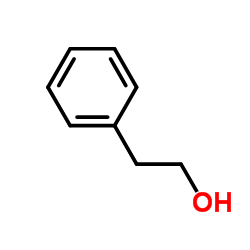Methylbenzylalcohol

Methylbenzylalcohol structure
|
Common Name | Methylbenzylalcohol | ||
|---|---|---|---|---|
| CAS Number | 98-85-1 | Molecular Weight | 122.164 | |
| Density | 1.0±0.1 g/cm3 | Boiling Point | 206.9±8.0 °C at 760 mmHg | |
| Molecular Formula | C8H10O | Melting Point | 19-20 °C(lit.) | |
| MSDS | Chinese USA | Flash Point | 85.0±0.0 °C | |
| Symbol |

GHS07 |
Signal Word | Warning | |
|
Combined effects of nutrients and temperature on the production of fermentative aromas by Saccharomyces cerevisiae during wine fermentation.
Appl. Microbiol. Biotechnol. 99(5) , 2291-304, (2015) Volatile compounds produced by yeast during fermentation greatly influence the organoleptic qualities of wine. We developed a model to predict the combined effects of initial nitrogen and phytosterol content and fermentation temperature on the production of v... |
|
|
Xylella fastidiosa esterase rather than hydroxynitrile lyase.
ChemBioChem. 16(4) , 625-30, (2015) In 2009, we reported that the product of the gene SCJ21.16 (XFa0032) from Xylella fastidiosa, a xylem-restricted plant pathogen that causes a range of diseases in several important crops, encodes a protein (XfHNL) with putative hydroxynitrile lyase activity. ... |
|
|
RNA-Seq Based De Novo Transcriptome Assembly and Gene Discovery of Cistanche deserticola Fleshy Stem.
PLoS ONE 10 , e0125722, (2015) Cistanche deserticola is a completely non-photosynthetic parasitic plant with great medicinal value and mainly distributed in desert of Northwest China. Its dried fleshy stem is a crucial tonic in traditional Chinese medicine with roles of mainly improving ma... |
|
|
Enzyme-Modified Particles for Selective Biocatalytic Hydrogenation by Hydrogen-Driven NADH Recycling.
ChemCatChem 7 , 3480-3487, (2015) We describe a new approach to selective H2-driven hydrogenation that exploits a sequence of enzymes immobilised on carbon particles. We used a catalyst system that comprised alcohol dehydrogenase, hydrogenase and an NAD(+) reductase on carbon black to demonst... |
|
|
Growth-rate dependency of de novo resveratrol production in chemostat cultures of an engineered Saccharomyces cerevisiae strain.
Microb. Cell Fact. 14 , 133, (2015) Saccharomyces cerevisiae has become a popular host for production of non-native compounds. The metabolic pathways involved generally require a net input of energy. To maximize the ATP yield on sugar in S. cerevisiae, industrial cultivation is typically perfor... |
|
|
Interplay of metalloligand and organic ligand to tune micropores within isostructural mixed-metal organic frameworks (M'MOFs) for their highly selective separation of chiral and achiral small molecules.
J. Am. Chem. Soc. 134(20) , 8703-10, (2012) Four porous isostructural mixed-metal-organic frameworks (M'MOFs) have been synthesized and structurally characterized. The pores within these M'MOFs are systematically tuned by the interplay of both the metalloligands and organic ligands which have enabled u... |
|
|
Characterization of aroma compounds in Chinese bayberry (Myrica rubra Sieb. et Zucc.) by gas chromatography mass spectrometry (GC-MS) and olfactometry (GC-O).
J. Food Sci. 77(10) , C1030-5, (2012) The aroma-active compounds in Chinese bayberry were identified using gas chromatography-olfactometry (GC-O) and GC-mass spectrometry techniques. The volatile compounds were extracted using Liquid-liquid extraction, solvent-assisted flavor evaporation and head... |
|
|
Fractionation and identification of minor and aroma-active constituents in Kangra orthodox black tea.
Food Chem. 167 , 290-8, (2014) The aroma constituents of Kangra orthodox black tea were isolated by simultaneous distillation extraction (SDE), supercritical fluid extraction and beverage method. The aroma-active compounds were identified using gas chromatography-olfactometry-mass spectrom... |
|
|
Lipase entrapment in protamine-induced bio-zirconia particles: Characterization and application to the resolution of (R,S)-1-phenylethanol
Enzyme Microb. Technol. 51(1) , 40-6, (2012) Highlights ► Lipase was entrapped in zirconia particles by bio-mineralization of K2ZrF6. ► Zirconia particles with or without lipase owned good spherical structure of 150nm. ► The entrapped lipase showed improved thermal, pH, recycling and storage stabilities... |
|
|
Comparison of artificial neural network (ANN) and response surface methodology (RSM) in optimization of the immobilization conditions for lipase from Candida rugosa on Amberjet(®) 4200-Cl.
Prep Biochem Biotechnol. 43(1) , 33-47, (2013) Candida rugosa lipase (CRL) is an important industrial enzyme that is successfully utilized in a variety of hydrolysis and esterification reactions. This work describes the optimization of immobilization conditions (enzyme/support ratio, immobilization temper... |